Dear Florida Climate Center Friends,
We'd like to present you with the July 2014 edition of our newsletter. In this newsletter, you'll find our monthly climate summary, a list of special events that our staff attended, some pictures, and more. If you have any questions, please email us at climate@coaps.fsu.edu.
Thanks,
The Staff of the Florida Climate Center
 |  |  | David Zierden
State Climatologist | James O'Brien
Professor Emeritus | Melissa Griffin
Asst. State Climatologist |
|
June Climate Summary for Florida
The Florida Climate Center's June 2014 Florida Climate Summary is now available. The summary provides an analysis of temperature and precipitation trends across the state, along with data on hazardous weather, drought, the impacts of the weather and any records tied or broken for the month. During June, average temperatures and rainfall totals varied across Florida. ENSO-neutral conditions are continuing in the equatorial Pacific. The Climate Prediction Center (CPC) predicts above normal temperatures and normal precipitation for the state through September. Past summaries are archived here.
| June average temperatures and departures from normal (°F) for select cities. | 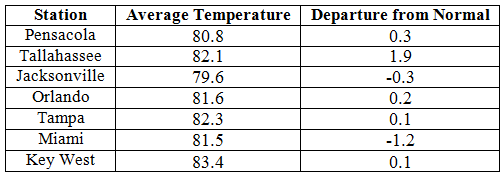 |
| June precipitation totals and departures from normal (°F) for select cities. |  |
| A graphical depiction of the monthly rainfall departure from normal (inches) for June (courtesy of NOAA, NWS). | 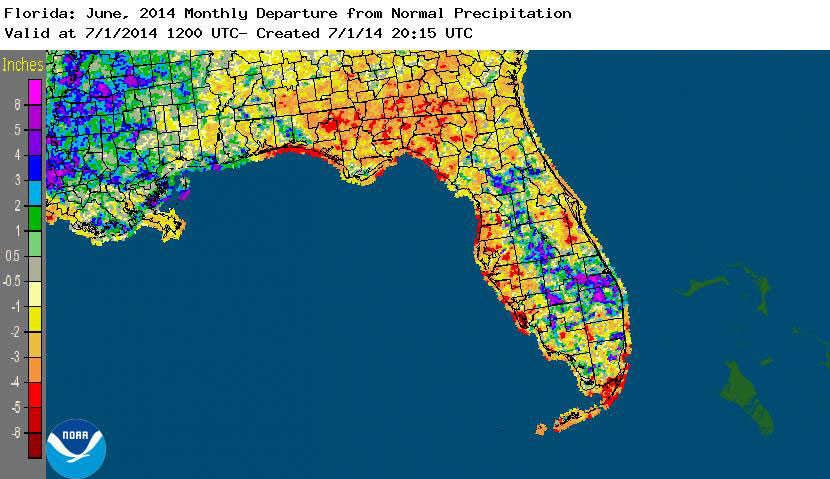 |
|
|
Update on the Current Situation of El Niņo
An El Niņo Watch was issued by the Climate Prediction Center back in March and continues to remain in effect as all eyes are on the equatorial Pacific to see how strong the upcoming El Niņo could be.
State Climatologist David Zierden has a special report on the developing El Niņo:
http://climatecenter.fsu.edu/el-nino
|
|
Rip Current and Lightning Safety
In June, the National Weather Service focuses on rip current and lightning safety awareness weeks.
Rip Current Safety
A rip current forms when waves break near the shoreline, and some of the waves break stronger in some locations than others. This causes a circulation of fast-moving water that travels back offshore. Even the most experienced swimmer can get caught in a rip current and unable to break free. So far in 2014, 5 people have lost their lives and 6 people have been rescued from rip currents. There are signs posted at most beaches of a diagram of what a rip current looks like, and what to do if you're caught in one. In addition, the state of Florida has a beach flag system that can easily describe the surf condition based on a color scale.
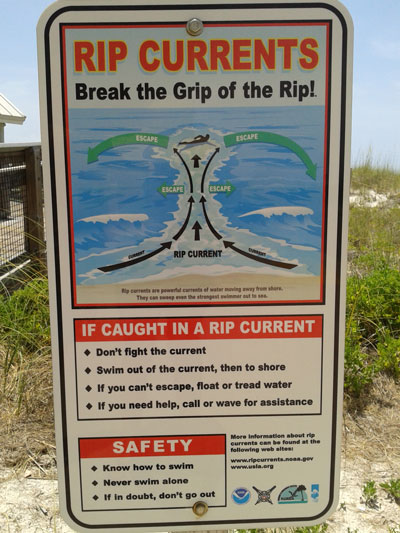 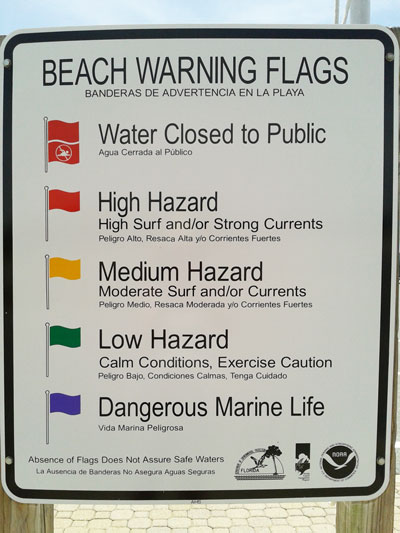 http://www.ripcurrents.noaa.gov/index.shtml http://www.ripcurrents.noaa.gov/index.shtml
Lightning Safety
Florida is the lightning capital of the continental United States, with some portions of the state seeing an average of more than 30 strikes per square mile each year. Since May 4 fatalities from lightning have been reported in the state, and June, July and August are months when there are increased outdoor activities. Remember, "When It Roars, Go Indoors."
http://www.lightningsafety.noaa.gov
This is a good time to review the excellent information and resources that the NWS has pulled together. If you have any visitors coming from out of state, it may be good to send them the links provided, so they can make sure they are aware of these summer hazards here in the Sunshine State.
|
|
Community Outreach
Assistant state climatologist Melissa Griffin took part in several outreach presentations last month, alongside Ms. Hannah Hiester and Ms. Brittany Pace, representatives from FSU's Center for Ocean-Atmospheric Prediction Studies (COAPS). The center hosted the Oasis Girls Camp for two separate presentations, one on the ocean and the other on weather. The girls participated in a weather knowledge quiz, hands on experiments with density, and were able to view some marine animal specimens. (insert Oasis Girls Photo)
In mid-June, she gave presentations at summer camps hosted by Literacy Volunteers of Leon County. One of the talks focused on a basic introduction to weather and climate, weather instruments and severe weather, while the other focused on understanding wind.
The final outreach presentation of the month was given to teachers and students as a part of the Gulf of Mexico Stewardship and Conversation Program at Florida A&M University. Teacher and students were given a presentation on weather and climate of Florida, with a focus on the hydrologic cycle before they were split into two groups. Ms. Rachel Weihs, PhD Meteorology student at COAPS, focused on discussions about professional development with the teachers, while the students took part in hands on experiments with Ms. Griffin and Mr. Zierden.
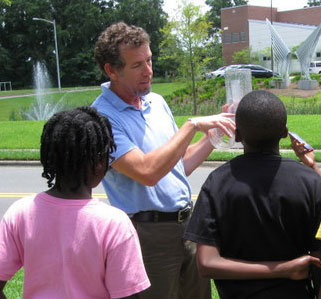
|
|
Continued Collaboration With The Florida Department of Health
Members from the Department of Health's Building Resilience Against Climate Effects (BRACE) visited the Florida Climate Center at the end of June to review progress on the work already completed under the CDC BRACE Grant, and to discuss the next stage of incorporating climate model data for the upcoming year under the grant. With insight from Dr. Tim LaRow and Dr. Lydia Stevanova from COAPS, the focus of the next few months will be making sure that BRACE members receive the data and proper guidance on the applications of the models for climate and health projections.
|
|
Upcoming Events
July 9-12, 2014:
Annual Meeting of the American Association of State Climatologist in Stevenson, WA
July 20-24, 2014:
National Association of County Agricultural Agents in Mobile, AL
August 12, 2014:
Advanced Farming Technologies for Reducing Climate Risks in Blackville, SC
September 3-5, 2014:
Southern Region Extension Climate Academy in Athens, GA
|
|
Special Report: Yellow Flies!
Folks who frequent or work outside close to wooded areas in Florida and the Southeast in the summer are familiar with yellow flies. What we call "yellow flies" often refers to several different species including deer flies, true yellow flies, and horse flies. These blood-sucking biting flies breed and lay their eggs in damp wooded areas and wetlands. The larvae live in wet soils over the winter before emerging from their pupae in the summer months.
Florida and the Southeast experienced the wettest summer on record last year and since then winter and spring rainfall has been plentiful. With all of the rain, there has been a wide expanse of suitable habitat for the biting flies to breed and mature. While there is no hard data to back this up, almost everyone agrees that this is the worst summer in memory for biting yellow flies.
If you are working or recreating outside near wooded areas, be sure to bring plenty of bug repellant (with DEET for maximum effectiveness) and wear long clothing. It looks like the plague of biting flies this summer is an unanticipated result of last year's climate extremes. Everything you ever wanted to know about yellow flies...
http://entnemdept.ifas.ufl.edu/creatures/livestock/deer_fly.htm

|
|
About Us
The Florida Climate Center is part of a three-tiered system of national, regional, and state climate offices, including NOAA's National Climatic Data Center and the Southeast Regional Climate Center. The Florida State Climatologist and other staff at the Florida Climate Center provide the following information and services to the people of Florida:
· Climate Data:
Historical weather observations for weather stations throughout the state of Florida. We are able to provide data for most stations from 1948-present.
· Climate Information:
Long-term historical averages for various stations, climate divisions, and the entire state.
· Extreme Event Records:
Information and analyses on extreme events such as freezes, droughts, floods and hurricanes.
· Special Analysis:
With their vast knowledge of El Niņo, La Niņa and climate variability, the State Climatologist and staff can offer expert insight into Florida's climate trends.
· Outreach:
Activities, presentations, and workshops that inform and educate the people of Florida about current and emerging climate issues. We also coordinate volunteers for the Community Collaborative Rain, Hail & Snow Network (CoCoRaHS).
More About Us
|
|